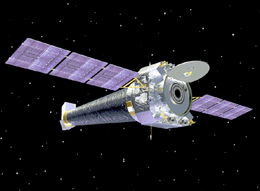August 12, 2004
MSFC NEWS RESEASE: 04-212

Chandra X-ray Image of 3C58
Illustrations: NGST
On Aug. 12, 1999, NASA's Chandra X-ray Observatory opened its sunshade doors for the first time, allowing celestial X-ray light to reach the observatory's mirrors. This one small step for the observatory proved to be a giant leap for science as Chandra began its mission to shed new light on a violent, mysterious universe invisible to the human eye. The Marshall Center manages the Chandra program.
On August 12, 1999, NASA's Chandra X-ray Observatory opened its sunshade doors for the first time, allowing celestial X-ray light to reach the observatory's mirrors. This one small step for the observatory proved to be a giant leap for science as Chandra began its mission to shed new light on a violent, mysterious universe invisible to the human eye.
"Humans cannot see X-rays, but Chandra can," said Chandra project scientist Dr. Martin C. Weisskopf of NASA's Marshall Space Flight Center in Huntsville, Ala. "And what the observatory has revealed in five short years has been nothing short of amazing. Thanks to Chandra, we've gleaned new information on dark energy, black holes, exploding stars and all other categories of astronomical objects."
"Chandra's resolving power is equivalent to the ability to read a newspaper headline a half-mile away," said Chandra Program Manager Keith Hefner of the Marshall Center. "It's an engineering marvel that has performed nearly flawlessly and provided major science discoveries over the past five years."
A Chandra timeline reveals some of its most noteworthy discoveries:
- Chandra finds a ring around the Crab Nebula. After only two months in space, the observatory reveals a brilliant ring around the heart of the Crab Pulsar in the Crab Nebula - the remains of a stellar explosion - providing clues about how the nebula is energized by a pulsing neutron, or collapsed, star. (Sept. 28, 1999)
- Chandra reveals a possible black hole in the Milky Way. Culminating 25 years of searching by astronomers, researchers say that a faint X-ray source, newly detected by Chandra, may be the long-sought X-ray emission from a known supermassive black hole at the center of our galaxy. (January 14, 2000)
- Chandra finds the most distant X-ray cluster. Using the Chandra Observatory, astronomers find the most distant X-ray cluster of galaxies yet. Approximately 10 billion light-years from Earth, the cluster 3C294 is 40 percent farther than the next most distant X-ray galaxy cluster. (Feb. 20, 2001)
- Chandra discovers X-rays from Jupiter. Using Chandra, astronomers discover a pulsating hot spot of X-rays in the polar regions of the planet's upper atmosphere and uncover evidence the X-ray source is not arising from the region of Jupiter where previously believed. (Aug. 29, 2002)
- Chandra makes first I.D. of a binary black hole. By revealing two active black holes in the nucleus of the extraordinarily bright galaxy NGC 6240, a Chandra image proves for the first time that two supermassive black holes can co-exist in the same galaxy. (Nov. 11, 2002)
- Chandra makes deepest X-ray exposure. A Chandra image, Deep Field North, captures for 23 days an area of the sky one-fifth the size of the full moon. Even though the faintest sources detected produced only one X-ray photon every four days, Chandra finds more than 600 X-ray sources, most of them supermassive black holes in galaxy centers. (June 19, 2003)
- Chandra sheds new light on the Vela Pulsar. Chandra offers new insight into pulsars, small and extremely dense stars. Created from a series of Chandra observations, an X-ray movie of the Vela pulsar reveals a spectacularly erratic jet that varies in a way never before seen, whipping about like an untended fire hose at about half the speed of light. (June 30, 2003)
- Chandra 'hears' a black hole. Using the Chandra Observatory, astronomers for the first time detect sound waves from a supermassive black hole. Coming from a black hole 250 million light years from Earth, the "note" is the deepest ever detected from an object in the Universe. (Sept. 9, 2003)
- Chandra finds evidence of new class of black holes. Chandra finds that mysterious, powerful X-ray sources found in nearby galaxies may represent a new class of objects. These sources, cooler than typical neutron-star or black-hole X-ray sources, may be a large new population of black holes with masses several hundred times that of the sun. (March 1, 2004)
- Chandra opens new line of investigation on dark energy. Using galaxy-cluster images from Chandra, astronomers apply a powerful, new method for detecting and probing dark energy. The results offer intriguing clues about the nature of dark energy and the fate of the Universe. (May 18, 2004)
NASA's Marshall Space Flight Center manages the Chandra program for the Office of Space Science, NASA Headquarters, Washington. Northrop Grumman of Redondo Beach, Calif., formerly TRW, Inc., was the prime development contractor for the observatory. The Smithsonian Astrophysical Observatory controls science and flight operations from the Chandra X-ray Center in Cambridge, Mass.
Additional information and images are available at:
MEDIA CONTACTS
Steve Roy
Marshall Space Flight Center, Huntsville, Ala.
(Phone: 256/544-6535)


